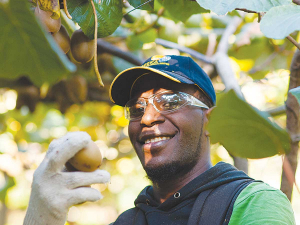Santa's present for the primary sector - an FTA with India
Primary sector leaders have welcomed the announcement of a Free Trade Agreement between India and New Zealand.
 The RSE scheme enables workers from the Pacific to come to NZ for six or seven months for harvest and pruning.
The RSE scheme enables workers from the Pacific to come to NZ for six or seven months for harvest and pruning.
HortNZ says the Government is moving in the right direction with its increase in recognised seasonal employers (RSE) workers.
But it says even more RSE workers are still needed to support horticulture’s big growth.
RSE is the name for the seasonal labour scheme where workers from the Pacific come to NZ for six to seven months for harvest and pruning. Once that work is done they return home to their families in the Pacific.
“RSE workers are playing a key role in the horticulture industry’s continued growth in response to rising export and domestic demand,” says HortNZ chief executive, Mike Chapman.
“NZ’s horticulture export revenue jumped 13.7% to $6.1 billion in the year to June 30, 2019. It’s expected to grow by another 3.8% to $6.3b in the current financial year.
“This growth is why we asked the Government for an even greater increase in RSE worker numbers, to support our growth and make up for the shortage of available NZ workers, particularly during peak times like harvesting and pruning.”
Chapman says it is good to have certainty for the current season and next season. The Government has provisionally announced that another 1600 RSE workers will be added, pushing the total from 14,400 this season to 16,000.
He says the RSE scheme has enabled the continued expansion of fruit, vegetable and wine grape growing in NZ.
“The availability of RSE workers also gives certainty to NZ businesses so they can continue to grow and employ additional permanent NZ workers.”
Hort NZ says last season Pacific RSE workers earned at least NZ$50 million.
A New Zealand dairy industry leader believes the free trade deal announced with India delivers wins for the sector.
The Coalition Government will need the support of at least one opposition party to ratify the free trade deal with India.
Primary sector leaders have welcomed the announcement of a Free Trade Agreement between India and New Zealand.
At Pāmu’s Kepler Farm in Manapouri, mating has wrapped up at the across-breed Beef Progeny Test.
More than 150 people turned up at Parliament recently to celebrate the 20th anniversary of Horticulture New Zealand (HortNZ).
Biosecurity New Zealand says Kiwis should continue to keep an eye out for yellow-legged hornets (Vespa velutina) over the holiday season.

OPINION: The release of the Natural Environment Bill and Planning Bill to replace the Resource Management Act is a red-letter day…
OPINION: Federated Farmers has launched a new campaign, swapping ‘The Twelve Days of Christmas’ for ‘The Twelve Pests of Christmas’ to…